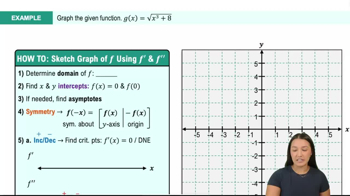Table of contents
- 0. Functions7h 52m
- Introduction to Functions16m
- Piecewise Functions10m
- Properties of Functions9m
- Common Functions1h 8m
- Transformations5m
- Combining Functions27m
- Exponent rules32m
- Exponential Functions28m
- Logarithmic Functions24m
- Properties of Logarithms34m
- Exponential & Logarithmic Equations35m
- Introduction to Trigonometric Functions38m
- Graphs of Trigonometric Functions44m
- Trigonometric Identities47m
- Inverse Trigonometric Functions48m
- 1. Limits and Continuity2h 2m
- 2. Intro to Derivatives1h 33m
- 3. Techniques of Differentiation3h 18m
- 4. Applications of Derivatives2h 38m
- 5. Graphical Applications of Derivatives6h 2m
- 6. Derivatives of Inverse, Exponential, & Logarithmic Functions2h 37m
- 7. Antiderivatives & Indefinite Integrals1h 26m
- 8. Definite Integrals4h 44m
- 9. Graphical Applications of Integrals2h 27m
- 10. Physics Applications of Integrals 2h 22m
5. Graphical Applications of Derivatives
Curve Sketching
Problem 4.4.78c
Textbook Question
{Use of Tech} Elliptic curves The equation y² = x³ - ax + 3, where a is a parameter, defines a well-known family of elliptic curves.
c. By experimentation, determine the approximate value of a (3 < a < 4)at which the graph separates into two curves.
 Verified step by step guidance
Verified step by step guidance1
Understand the problem: We are given the equation of an elliptic curve y² = x³ - ax + 3, where 'a' is a parameter. We need to find the approximate value of 'a' between 3 and 4 where the graph separates into two distinct curves.
Recall that the separation of the graph into two curves occurs when the discriminant of the cubic polynomial in x, which is x³ - ax + 3, becomes zero. This is because the discriminant being zero indicates a double root, leading to a cusp or a singular point on the curve.
The discriminant Δ of a cubic polynomial x³ + bx + c is given by the formula Δ = -4b³ - 27c². In our case, b = -a and c = 3, so substitute these values into the discriminant formula.
Set the discriminant equal to zero to find the critical value of 'a': -4(-a)³ - 27(3)² = 0. Simplify this equation to solve for 'a'.
Experiment with values of 'a' between 3 and 4 to find the approximate value where the discriminant becomes zero, indicating the separation of the graph into two curves.
 Verified video answer for a similar problem:
Verified video answer for a similar problem:This video solution was recommended by our tutors as helpful for the problem above
Video duration:
3mPlay a video:
Was this helpful?
Key Concepts
Here are the essential concepts you must grasp in order to answer the question correctly.
Elliptic Curves
Elliptic curves are defined by cubic equations in two variables, typically in the form y² = x³ + ax + b. They have important properties in number theory and algebraic geometry, particularly in relation to their group structure. The specific curve given, y² = x³ - ax + 3, is a family of elliptic curves parameterized by 'a', which affects the shape and intersection of the curve with the x-axis.
Recommended video:

Summary of Curve Sketching
Graph Behavior and Separation
The behavior of the graph of an elliptic curve can change based on the parameter 'a'. Specifically, the graph can separate into two distinct curves when the discriminant of the cubic equation changes sign, indicating a change in the number of real roots. This separation is crucial for understanding the nature of the solutions to the equation and can be explored through graphical or numerical methods.
Recommended video:

Graphing The Derivative
Numerical Experimentation
Numerical experimentation involves using computational tools or graphing techniques to explore mathematical phenomena. In this context, it means testing various values of 'a' within the specified range (3 < a < 4) to observe how the graph of the elliptic curve behaves. This approach helps in approximating the critical value of 'a' at which the curve separates, providing insights that may not be easily derived analytically.
Recommended video:

Finding Limits Numerically and Graphically

 11:41m
11:41mWatch next
Master Summary of Curve Sketching with a bite sized video explanation from Callie
Start learning



